Abstract
It is pointed out that in first-order phase transitions nucleation stops when the supersaturation decreases by a small amount. A simple quantitative description of the next stage of the kinetics of the transition — the growth stage — is proposed. This stage lasts much longer than the nucleation stage, and during practically the entire duration of this stage all nuclei have virtually the same size and the number of nuclei is constant, and the main drop in supersaturation occurs here.
Similar content being viewed by others
References
L. D. Landau and E. M. Lifshitz, Physical Kinetics [in Russian], Nauka, Moscow, 1979, Secs. 99, 100.
Yu. V. Mikhailova and L. A. Maksimov, Zh. Éksp. Teor. Fiz. 59, 1368 (1970) [Sov. Phys. JETP 32, 747 (1971)].
Author information
Authors and Affiliations
Additional information
Pis'ma Zh. Éksp. Teor. Fiz. 64, No. 1, 61–64 (10 July 1996)
Rights and permissions
About this article
Cite this article
Marchenko, V.I. On the theory of fog. Jetp Lett. 64, 66–69 (1996). https://doi.org/10.1134/1.567161
Received:
Issue Date:
DOI: https://doi.org/10.1134/1.567161




